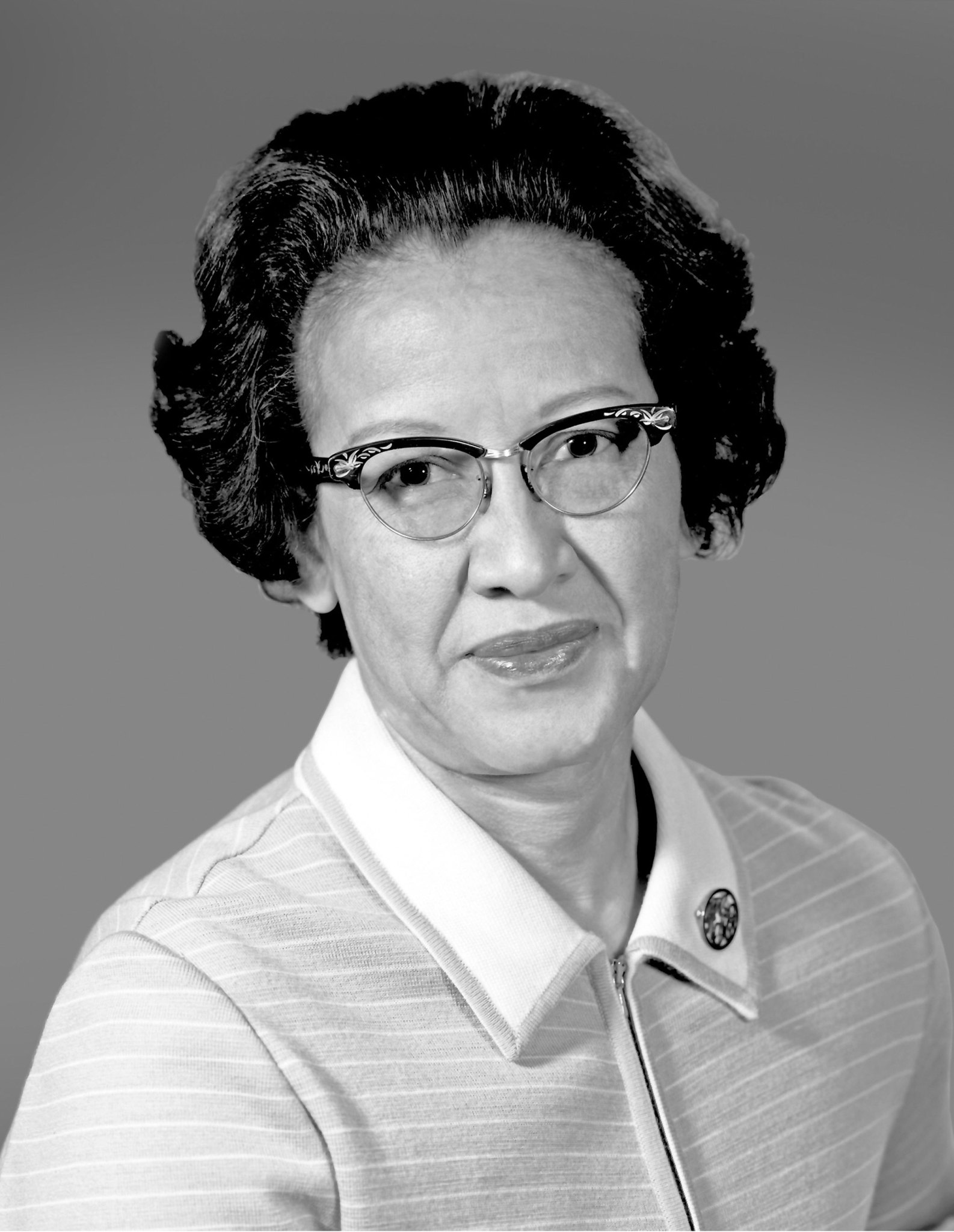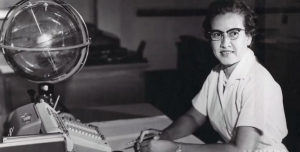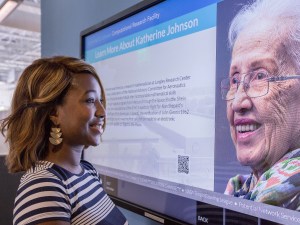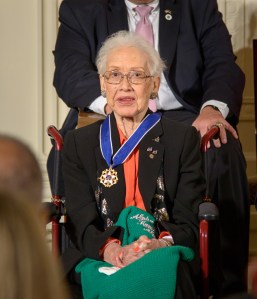Katherine Coleman Goble Johnson (1918– ) is an African-American mathematician who made valuable contributions to critical aeronautics and space programs of the NACA and NASA. Overcoming the constraints of segregation and gender bias, she progressed from mathematical tasks, such as computing experimental flight and ground-test data using a mechanical Frieden calculator for the NACA, to the application of spacecraft trajectories and spacecraft control calculations for NASA. Her life, 33-year career, and contributions are discussed in the best-selling 2016 book “Hidden Figures” by Margot Lee Shetterly and the Academy-Award nominated motion picture of the same name. Her story has become widely known and is a stimulus for the interests of young people in science, technology, engineering, and mathematics (STEM) activities across the nation.
Katherine Johnson was born in White Sulphur Springs, West Virginia, and quickly advanced through high school because of her intense interest and demonstrated expertise in mathematics. She attended West Virginia State College where she graduated with highest honors in 1937 with a bachelor of science degree in mathematics and French, and took a job teaching at a black public school in Virginia. When West Virginia decided to quietly integrate its graduate schools in 1939, she was one of the first three African-Americans selected to desegregate West Virginia State College. After the first session, however, she decided to leave school and start a family with her husband James F. Goble. When their three daughters got older, she returned to teaching.
She learned that the NACA Langley Aeronautical Laboratory was hiring a group of African-American mathematicians with teaching experience to perform mathematical calculations that transformed raw data that had been obtained using instrumentation into final engineering parameters. She began her career at Langley in the segregated West Computing section in the summer of 1953 under the supervision of fellow West Virginian Dorothy Vaughan. The pool of women mathematicians performing data reduction calculations were known as “computers.” Just two weeks into Katherine’s tenure in the office, Dorothy Vaughan assigned her to a project in the Maneuver Loads Branch of the Flight Research Division, where her position soon became permanent. She spent the next four years analyzing data from flight tests, and worked on the investigation of a plane crash caused by an encounter with wake turbulence. She was assertive, asking to be included in editorial meetings (where no women had gone before). It was during this time that her husband James died of cancer in December 1956.
The launch of the Soviet satellite Sputnik in October 1957 changed aerospace history—and Katherine Johnson’s life. In 1957, Johnson provided some of the descriptive material for a 1958 document “Notes on Space Technology,” a compendium of a series of 1958 lectures given to staff members by engineers in the Flight Research Division and the Pilotless Aircraft Research Division (PARD). Engineers from those groups formed the core of the Space Task Group (STG), NASA’s first official foray into space research, and Katherine, who had worked with many of them since coming to Langley, “came along with the program” as the NACA became NASA later that year. While not a member of the STG, she developed an interest in calculating trajectories of spacecraft and satellites.
She experienced a highlight of her life when she married her second husband, Colonel James A. Johnson, in 1959.
In 1960, Johnson and engineer Ted Skopinski coauthored a report entitled “Determination of Azimuth Angle at Burnout for Placing a Satellite Over a Selected Earth Position,” using basic “two-body” equations for an orbital spaceflight in which the landing position of the spacecraft is specified. Such equations could be solved using a Frieden calculator. It was the first time a woman in the Division had received credit as an author of a research report. She also was coauthor of a report in 1962 on the orbital behavior of the first communications satellite, Echo I (a 100-ft-diameter inflatable balloon). That effort was a pioneering contribution because it was the first satellite whose orbit was affected by solar pressure.
When interviewed for the book “Hidden Figures,” Johnson discussed her activities in Project Mercury and the Apollo missions. She recalled doing trajectory analysis for Alan Shepard’s May 1961 Mercury mission, America’s first human suborbital spaceflight. She also remembered how, in 1962, as NASA prepared for the orbital mission of John Glenn, the complexity of the orbital flight had required the construction of a worldwide communications network, linking tracking stations around the world to IBM computers in Washington, DC, Cape Canaveral, and Bermuda. The network provided tracking and communications of Glenn’s spacecraft from blast off to splashdown. According to Johnson, Glenn asked engineers to “get the girl”—Katherine Johnson—to run the same numbers through the same equations that had been programmed into the computers, but by hand, on her desktop mechanical calculating machine. “If she says they’re good,” she remembers the astronaut saying, “then I’m ready to go.” Glenn’s flight was a success, and marked a turning point in the competition between the United States and the Soviet Union in space.
After Project Mercury, she joined the Space Mechanics Division, and calculated the trajectory for the 1969 Apollo 11 flight to the Moon, and computed backup navigational charts for astronauts in case of electronic failures. In 1970, Apollo 13’s aborted mission to the Moon made use of her earlier research on backup parameters and charts, enabling the crew to safely return to Earth four days later. Later in her career, as a member of the Flight Dynamics and Control Division, she worked on the Space Shuttle program, the Earth Resources Satellite, and plans for a mission to Mars. Her final projects before retirement included analysis of guidance and control of large flexible structures.
When asked to name her greatest contribution to space exploration, Johnson highlights the calculations that helped synchronize Project Apollo’s Lunar Lander with the moon-orbiting Command and Service Module. She authored or coauthored 13 research reports during her career.
Katherine Johnson retired in 1986. Her legacy includes an extraordinary social impact as a pioneer in space science and computing that may be seen both from the honors she has received and the number of times her story is presented as a role model to aspiring young people. Since 1979 (before she retired from NASA), Johnson’s biography has had a place in lists of African-Americans in science and technology. In 2015, President Barack Obama awarded Johnson the Presidential Medal of Freedom, citing her as a pioneering example of African-American women in science, technology, engineering, and mathematics (STEM). In 2016, NASA dedicated a new Katherine G. Johnson Computational Research Facility at the Langley Research Center. Dr. Johnson was included in the list of “BBC 100 Women”, a list of 100 inspiring and influential women from around the globe. Her awards include the Astronomical Society of the Pacific’s Arthur B.C. Walker II Award (2016); a NASA Silver Snoopy award (2016); an Honorary Doctorate of Science from Old Dominion University (2010); an Honorary Doctor of Science by the Capitol College, Laurel, Maryland (2010); the West Virginia State College Outstanding Alumnus of the Year (1999); and an Honorary Doctor of Laws, from SUNY Farmingdale (1998).
Katherine Johnson and her husband reside in Newport News, Virginia, and have two daughters: Joylette, and Katherine. A third daughter, Constance is deceased. Katherine Johnson is now 98 years old.


























